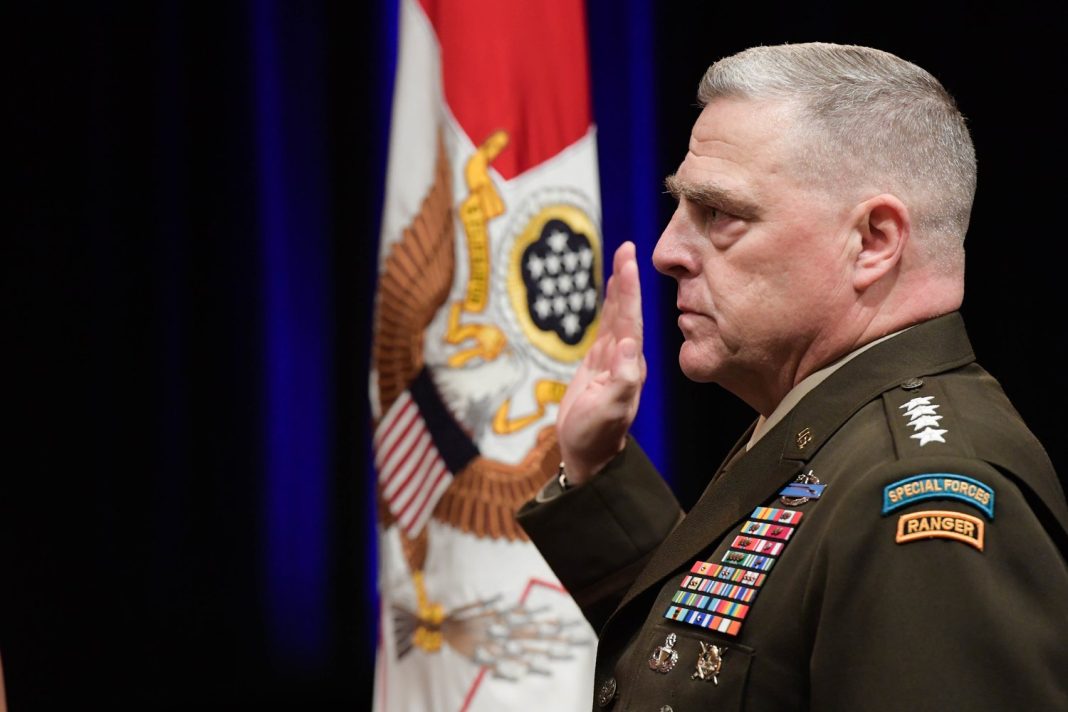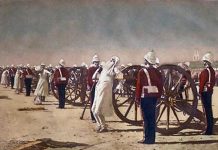Notes:
[1] Robert Kagan provides an extensive discussion of the incident. He asserts that “the military remains as wedded as ever to the tradition of military abstention”, despite Milley’s misstep, in Robert Kagain, “The Battle of Lafayette Square and the Undermining of American Democracy” Brookings, June 6, 2020, https://www.brookings.edu/articles/the-battle-of-lafayette-square-and-the-undermining-of-american-democracy/. Also, Kori M. Schake has argued in traditional civil-military relations terms that Milley’s behavior was apolitical and appropriate in Kori M. Schacke, “The Military and the Constitution Under Trump” Survival: Global Politics and Strategy, Vol. 62 (2022) https://doi.org/10.1080/00396338.2020.1792096
[2] David Welna, “Gen. Mark Milley Says Accompanying Trump To Church Photo-Op Was A Mistake,” NPR, June 11, 2020, https://www.npr.org/sections/live-updates-protests-for-racial-justice/2020/06/11/875019346/gen-mark-milley-says-accompanying-trump-to-church-photo-op-was-a-mistake
[3] Ibid.
[4] We draw a significant distinction here between “structured” and “unstructured”. Officers, Non-Commissioned Officers, and Warrant Officers who rise to the top of their fields will have almost certainly benefited from mentors passing on hard-won lessons in political effectiveness. War Colleges, as well as CAPSTONE, and PINNACLE-type courses, likewise create unstructured or loosely-structured opportunities for officers to meet and learn from a variety of politically-savvy actors, in uniform and out. What is missing, and what we call for, is explicit and transparent education in gaining appropriate political competencies.
[5] McChrystal in the book by Lawrence Freedman, Command: The Politics of Military Operations from Korea to Ukraine (Dublin: Allen Lane, 2022), pp. 513.
[6] For work on influence tactics see: Falbe, Cecilia M., and Gary Yukl. “Consequences for Managers of Using Single Influence Tactics and Combinations of Tactics.” Academy of Management Journal 35, no. 3 (1992): 638-52.; for work on ’hard’ versus ’soft’ influence tactics see van Knippenberg, Barbara, Rob van Eijbergen, and Henk Wilke. “The Use of Hard and Soft Influence Tactics in Cooperative Task Groups.” Group Processes & Intergroup Relations 2, no. 3 (1999): 231-44.
[7] These civil-military relations were of interest because they had already begun to show signs of stressing America’s democratic institutions. See William T.R. Fox, “Civil-Military Relations: The SSRC Committee and Its Research Survey”, World Politics 6, no. 2 (1954): 278-288.
[8] See pages 22-23 of Thomas Crosbie “What is Military Politics?” in Military Politics: New Perspectives ed. Thomas Crosbie, (Berghahn Books, 2023).
[9] Damon Coletta and Thomas Crosbie, “The Virtues of Military Politics” Armed Forces and Society 47:1 (2021): 3-24.
[10] Peter D. Feaver, “The Civil-Military Problematique: Huntington, Janowitz, and the Question of Civilian Control” Armed Forces and Society 23:2 (1996), pp. 149-178; and Peter D. Feaver Armed Servants: Agency, Oversight, and Civil-Military Relations (Harvard University Press, 2003); and Rebecca L. Schiff, “Civil-Military Relations Reconsidered: A Theory of Concordance” Armed Forces Society Vol. 22, No.1 (Fall 1995), pp. 7-24; and Deborah Avant “Conflicting Indicators of “Crisis” in American Civil-Military Relations” Armed Forces & Society” (April 1998).
[11] See Suzanne C. Nielsen “Civil Military Relations Theory and Military Effectiveness” in Handbook of Military Administration ed. Jeffrey A. Weber and Johan Eliasson (New York: Routledge, 2007); See also Deborah D. Avant “Are the Reluctant Warriors Out of Control? Why the U.S. Military is Averse to Responding to post-Cold War Low-Level Threats” Security Studies 6:2 (1996/1997), pp. 51-90, since Avant also used the Principal-Agent framework.
[12] Peter D. Feaver, Armed Servants: Agency, Oversight, and Civil-Military Relations (Harvard University Press, 2003); and Thomas Crosbie “What is Military Politics?” in Military Politics: New Perspectives, ed. Thomas Crosbie (Berghahn Books, 2023), pp. 27-30.
[13] This argument is expanded in Thomas Crosbie “What is Military Politics?” in Military Politics: New Perspectives ed. Thomas Crosbie (Berghahn Books, 2023) pp. 27-30.
[14] David Pion-Berlin and Andrew Ivey, “Military dissent in the United States: Are there lessons from Latin America?” Defense & Security Analysis, Taylor & Francis Journals, Vol 37(2) (April 2021), pp. 36-37.
[15] Risa Brooks, “Paradoxes of Professionalism: Rethinking Civil-Military Relations in the United States,” International Security 44(4) (2020), pp. 7-44.
[16] Samuel P. Huntington, Changing Patterns of Military Politics, (Free Press, 1962)
[17] See Thomas Crosbie “What is Military Politics?,” in Military Politics: New Perspectives ed. Thomas Crosbie (Berghahn Books, 2023) pp. 30-33, for a summary of this literature.
[18] Thomas Crosbie, “Military Politics as Research Program” in Military Politics: New Perspectives, ed. Thomas Crosbie (Berghahn Books, 2023), pp. 246-252
[19] Carsten F. Roennfeldt “Wider Officer Competencies: The Importance of Politics and Practical Wisdom,” Armed Forces and Society 45:1 (2019), pp. 59-77, and; Charles D. Allen “Military Officers Need to Be Politically Savvy,” Australian Journal of International Affairs (2018) – The attributes noted by Allen are social astuteness, interpersonal influence, networking, and apparent sincerity. See also Damon Coletta and Thomas Crosbie, “The Virtues of Military Politics,” Armed Forces and Society 47(1) (2019): 3-24.
[20] James M. Dubrik, “Taking a ‘Pro’ Position on Principled Resignation,” Armed Forces and Society 43:1 (2017), pp. 17-28; and Peter D. Feaver, “Resign in Protest? A Cure Worse than Most Diseases,” Armed Forces and Society, 43:1 (2017), pp. 29-40; and Richard H. Kohn, “On Resignation,” Armed Forces and Society, 43:1 (2017), pp. 41-52; and Don M. Snider, “Dissent, Resignation, and the Moral Agency of Senior Military Professionals,” Armed Forces and Society, 43:1 (2017), pp. 5-16.
[21] see Falbe and Yukl (1992) see also Lee, Soojin, Soojung Han, Minyoung Cheong, Seckyoung Loretta Kim, and Seokwha Yun. “How Do I Get My Way? A Meta-Analytic Review of Research on Influence Tactics.” The Leadership Quarterly 28, no. 1 (2017): 210-28.
[22] see van Knippenberg, van Eijbergen, and Wilke (1999)










